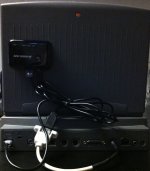Has anyone experimented with ethernet to wifi bridges/gaming adapters on laptops with builtin ethernet but not wifi?
I've been looking at http://www.netgear.com/landing/wnce2001.aspx for possibly making a powerbook 540c a little more mobile without the difficult to obtain PCMCIA card cage. I can be powered off 5V, which is what the internal floppy drive uses. I'm not sure how much current the floppy is allowed to draw and if this would draw too much.
Anyway, just thought I'd see if anyone else has tried something similar before I order one of these things.
I've been looking at http://www.netgear.com/landing/wnce2001.aspx for possibly making a powerbook 540c a little more mobile without the difficult to obtain PCMCIA card cage. I can be powered off 5V, which is what the internal floppy drive uses. I'm not sure how much current the floppy is allowed to draw and if this would draw too much.
Anyway, just thought I'd see if anyone else has tried something similar before I order one of these things.



